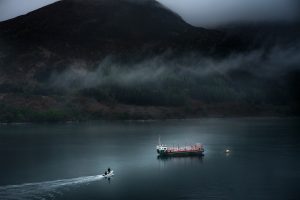Iconic Scottish vessels were celebrated at the National Historic Ships UK Awards 2023, filmed aboard The Royal Yacht Britannia in Leith.
This year’s theme was ‘In All Weathers’, and it attracted nearly 500 entries featuring historic vessels in all conditions from brilliant sunshine to stormy seas, or the still waters of the lakes and inland waterways. The winners were announced by historian and presenter Dan Snow.
Two of the winning images in the 2023 Photography Competition featured West Coast vessels; the world’s last remaining manually operated turntable ferry MV Glenachulish (Glenelg, Ross-shire) and Clyde Puffer VIC 32 (Crinan, Argyll).
Wayne Starkey’s striking image of the National Historic Fleet ‘puffer’ VIC 32 was a runaway winner with the judging panel for Newcomer of the Year.
His photograph was taken whilst on holiday in the Scottish fishing village of Tayvallich on the shores of Loch Sween. Returning from a walk one evening, they heard a foghorn, and, looking over the bay, saw the majestic sight of a steamboat anchored there.
VIC 32 was built in 1943 at Richard Dunston’s Shipyard in Thorne, Yorkshire, and is celebrating her 80th birthday this year. Her design was based on a 1939 Puffer design from the vessels Anzac and Lascar, built by Scott’s of Bowling near Glasgow for J Hay & Sons Ltd, Kirkintilloch.
Puffers were boats which operated around the coast of Scotland, mainly on the west coast, supplying the remote areas of the Highlands and islands with everything needed for the sparse populations in these remote areas. Distilleries were also a large user of puffers, both for supply of raw materials, especially coal, and for shipping full whisky barrels to Glasgow.
During the war, VIC 32 is believed to have carried cement for pier building on Barra and is known to have participated in the construction of the Churchill Barriers at Scapa Flow. VIC 32 also carried ammunition and aviation fuel supplies to the fleet in Loch Eil and Scapa Flow.
On transfer to the Admiralty after the war in 1947, she was renamed C702 and is known to have worked at the dockyards at Devonport and Rosyth. Saved from scrapping in 1963, VIC 32 has operated steamboat holidays in Scotland since the 1970s, around the Clyde estuary, the Sound of Jura, and the Caledonian Canal between Corpach and Inverness. Today, she is operated by Puffer Steamboat Holidays Ltd, a wholly owned a subsidiary of the Puffer Preservation Trust.
The only Award voted for by the public, the People’s Choice Award is always popular and closely fought on Instagram. Ian Southerin’s photograph was a runaway winner of the People’s Choice Final, receiving nearly 150 more votes than the runner up.

Ian’s dramatic image of the Glenelg to Skye ferry MV Glenachulish, the world’s last remaining manually operated turntable ferry, was taken while he was working at the Ferry Shore Station for six months.
Ian wanted to reflect that the Skye Ferry works in ‘All Weathers’, so he deliberately waited until it was raining – in general you get the best pictures in the worst weather, he says! He also wanted to include the crew within the picture. Ian took a sabbatical from his regular work to enjoy a completely different life for the summer and enjoyed it so much he plans to do the same next year.
One of the ‘youngest’ craft on the National Register of Historic Vessels, MV Glenachulish was built in 1969 by Ferguson Ailsa Ltd, Ayrshire and is in regular service between Easter and October. Since 1983, Glenachulish has plied the Kyle Rhea Narrows, the oldest and fastest ferry route to the Isle of Skye.
Once a common sight throughout the Highlands, ‘wee ferries’ were the road links before the building of bridges. This is where Vikings crossed the surging straits coping with the eight-knot current, and drovers brought herds of Hebridean black cattle to swim across from Kylerhea on Skye to Glenelg and continue their way south to market – a head count of some 8,000 beasts per year.
There has been a car ferry service here since 1934, although there was an extended break through WWII when access to local waters was restricted due to their importance as a centre for naval operations. In 2006, when the owner operator retired, the Isle of Skye Ferry Community Interest Company was set up to purchase and operate the ferry and works to secure this economic lifeline in the interest of the local community.
In June 2022, MV Glenachulish was awarded the title of NHS-UK’s Operational Flagship of the Year.